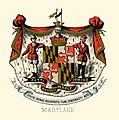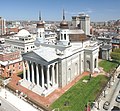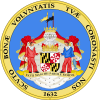Portal:Maryland
|
Maryland Portal
|
Baltimore Task Force
|
Frederick Task Force
|
Montgomery Task Force
|
WikiProject Maryland
|
|
Main page
|
Discussion
|
Introduction Maryland (US: /ˈmɛrɪlənd/ ⓘ MERR-il-ənd) is a state in the Mid-Atlantic region of the United States. The state borders Virginia to its south, West Virginia to its west, Pennsylvania to its north, Delaware to its east, the Atlantic Ocean, and the national capital of Washington, D.C. With a total area of 12,407 square miles (32,130 km2), Maryland is the ninth-smallest state by land area, and its population of 6,177,224 ranks it the 18th-most populous state and the fifth-most densely populated. Maryland's capital is Annapolis, and the most populous city is Baltimore. Occasional nicknames include Old Line State, the Free State, and the Chesapeake Bay State. It is named after Henrietta Maria, the French-born queen of England, Scotland, and Ireland during the 17th century. Maryland's coastline was first explored by Europeans in the 16th century. Prior to that, it was inhabited by several Native American tribes, mostly the Algonquian peoples and, to a lesser degree, Iroquoians and Siouans. As one of the original Thirteen Colonies, Maryland was founded by George Calvert, 1st Baron Baltimore, a Catholic convert who sought to provide a religious haven for Catholics persecuted in England. In 1632, Charles I of England granted Lord Baltimore a colonial charter, naming the colony after his wife, Henrietta Maria. Unlike the Pilgrims and Puritans, Lord Baltimore envisioned a colony where people of different religious sects would coexist under the principle of toleration. In 1649, the Maryland General Assembly passed an Act Concerning Religion, which enshrined this principle by penalizing anyone who "reproached" a fellow Marylander based on religious affiliation. Nevertheless, religious strife was common in the early years, and Catholics remained a minority, albeit in greater numbers than in any other English colony. Maryland's early settlements and population centers clustered around rivers and other waterways that empty into the Chesapeake Bay. Its economy was heavily plantation-based and centered mostly on the cultivation of tobacco. Demand for cheap labor from Maryland colonists led to the importation of numerous indentured servants and enslaved Africans. In 1760, Maryland's current boundaries took form following the settlement of a long-running border dispute with Pennsylvania. Maryland was an active participant in the events leading up to the American Revolution, and by 1776, its delegates signed the Declaration of Independence. Many of its citizens subsequently played key political and military roles in the war. Although then a slave state, Maryland remained in the Union during the American Civil War, its strategic location giving it a significant role in the conflict. After the Civil War, Maryland took part in the Industrial Revolution, driven by its seaports, railroad networks, and mass immigration from Europe. Since the 1940s, the state's population has grown rapidly, to approximately six million residents, and it is among the most densely populated U.S. states. , Maryland had the highest median household income of any state, owing in large part to its proximity to Washington, D.C., and a highly diversified economy spanning manufacturing, retail services, public administration, real estate, higher education, information technology, defense contracting, health care, and biotechnology. Maryland is one of the most multicultural states in the country; it is one of the six states where non-Whites compose a majority of the population, with the fifth-highest percentage of African Americans, and high numbers of residents born in Africa, Asia, Central America, and the Caribbean. The state's central role in U.S. history is reflected by its hosting of some of the highest numbers of historic landmarks per capita. (Full article...) This is a Featured article, which represents some of the best content on English Wikipedia..
 The Maryland Tercentenary half dollar was a commemorative fifty-cent piece issued by the United States Bureau of the Mint in 1934. It depicts Cecil Calvert, 2nd Baron Baltimore on the obverse and the Coat of Arms of Maryland on the reverse. The Maryland Tercentenary Commission sought a coin in honor of the 300th anniversary of the arrival of English settlers in Maryland. The state's two senators introduced legislation for such a piece, and it passed both houses of Congress with no opposition. A design had already been prepared by Professor Hans Schuler; it passed review by the Commission of Fine Arts, though there was controversy then and since over whether Lord Baltimore, a Cavalier and Catholic, would have worn a collar typical of Puritans. (Full article...)General imagesIn the news
On this day...This is a Good article, an article that meets a core set of high editorial standards.
 The Crab Bowl Classic is the name given to the Maryland–Navy football rivalry. It is an American college football rivalry between the Maryland Terrapins football team of the University of Maryland and the Navy Midshipmen football team of the United States Naval Academy. The two institutions, located in close proximity in the state of Maryland, first met for a football game in 1905. Since then, the series has often been marked by controversy, with incidents by players and supporters occurring both on and off the field. The winner of the game is awarded the Crab Bowl Trophy. Navy dominated the series early by winning the first eight games, between 1905 and 1930, which remains the longest streak. Maryland secured its first win in 1931 at a neutral site in Washington, D.C. After two more meetings, the series was suspended in 1934 when the Maryland administration protested a play. (Full article...)Selected article - The Baltimore and Ohio Railroad (reporting mark BO) was the first common carrier railroad and the oldest railroad in the United States. It operated as B&O from 1830 until 1987, when it was merged into the Chessie System; its lines are today controlled by CSX Transportation. The railroad was founded to serve merchants from Baltimore who wanted to do business with settlers crossing the Appalachian Mountains. It would compete with several existing and proposed turnpikes and canals, including the Erie and Chesapeake and Ohio Canal. Building west from the port of Baltimore, the B&O reached Sandy Hook, Maryland, in 1834; Cumberland in 1842; the Ohio River at Moundsville, Virginia, in 1852; Wheeling, Virginia, in 1853; and in 1857, Parkersburg, Virginia, below rapids that made navigation difficult during parts of the year. (Full article...)Did you know?

SubcategoriesSelect [+] to view subcategories
TopicsRelated portalsAssociated WikimediaThe following Wikimedia Foundation sister projects provide more on this subject:
Discover Wikipedia using portals |






















































